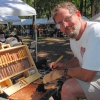After the main features of the face have been added, in a 'first pass' as it were, a second pass that refines what we've done will sharpen everything.

| 18 April 2014 08:25
Well, looking forward to "green Man II"... (Hint, hint). With your video skills (both of you) maximized over the years, would love to see you actually totally doing some of those curvy leaves!! Thanks for everything.

| 12 December 2011 10:12
Love these longer vids with lots of tool work. Also the level of instruction is just right for me; not too basic, not too advanced, although I can't really picture what 'more advanced' would be since, aside from explaining what he is doing while he is doing it, this is probably just Chris' normal carving procedure. Yes?

| 28 May 2011 06:19
Don, fair point, sorry I didn't make it clearer. In this carving, I would use a 'nail punch' wherever I previously used the #9 x 1/8 3mm gouge earlier in the series, when I popped out little cylinders of wood. So: the ends of the mouth and nose 'wings' on either side; also, possibly, to deepen the iris around the pupil or between the front teeth. Traditional carvers use punches like this - tapped in with a hammer or mallet, to emphasise a shadow in a discrete place - and making an appropriate punch as needed. In this case, simply flatten the point of a suitable nail. Really. Which has got to be the cheapest carving tool you'll ever own! You can see me using punches like this in the Gothic Lintel series (#5 - 2:35 & 2:52 and #6 - 5:26). I'm not talking about a 'background' - there isn't one, so nothing to dimple - just accenting little shadows. All the surfaces of the face and leaves are left from the cutting edge. Hope this makes it clear.

| 24 May 2011 08:14
I'm a bit confused with the comment at the end of this lesson regarding "use a flattened nail to punch".
I don't follow that at all. First it isn't clear to me what part or parts is being punched and don't know anything about a nail being used as a tool? Is the nail simply ground at the pointed end making it flat? And wouldn't that simply texture the background with dimple's?